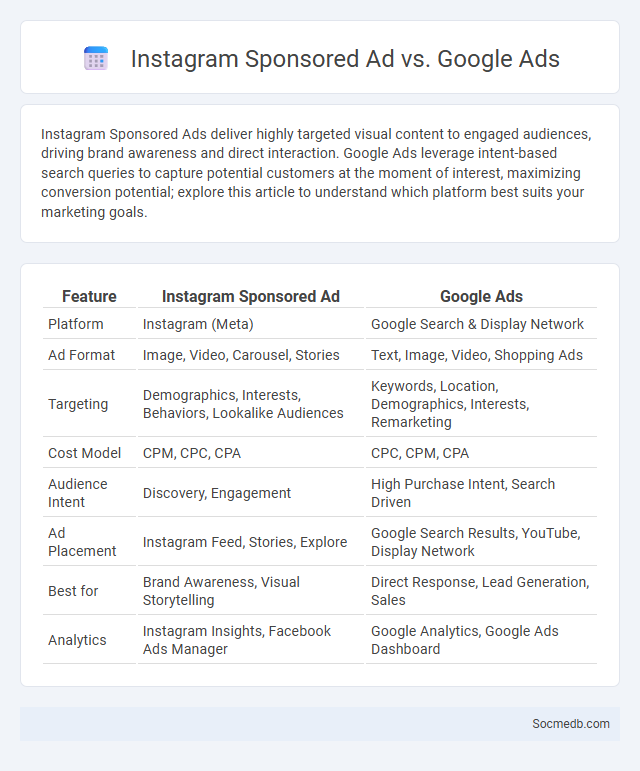
Photo illustration: Instagram Sponsored Ad vs Google Ads
Instagram Sponsored Ads deliver highly targeted visual content to engaged audiences, driving brand awareness and direct interaction. Google Ads leverage intent-based search queries to capture potential customers at the moment of interest, maximizing conversion potential; explore this article to understand which platform best suits your marketing goals.
Table of Comparison
| Feature | Instagram Sponsored Ad | Google Ads |
|---|---|---|
| Platform | Instagram (Meta) | Google Search & Display Network |
| Ad Format | Image, Video, Carousel, Stories | Text, Image, Video, Shopping Ads |
| Targeting | Demographics, Interests, Behaviors, Lookalike Audiences | Keywords, Location, Demographics, Interests, Remarketing |
| Cost Model | CPM, CPC, CPA | CPC, CPM, CPA |
| Audience Intent | Discovery, Engagement | High Purchase Intent, Search Driven |
| Ad Placement | Instagram Feed, Stories, Explore | Google Search Results, YouTube, Display Network |
| Best for | Brand Awareness, Visual Storytelling | Direct Response, Lead Generation, Sales |
| Analytics | Instagram Insights, Facebook Ads Manager | Google Analytics, Google Ads Dashboard |
Overview of Instagram Sponsored Ads
Instagram Sponsored Ads are paid promotional posts designed to increase brand visibility and user engagement by targeting specific audiences based on demographics, interests, and behaviors. Utilizing Facebook's advanced advertising platform, these ads can appear in users' feeds, Stories, Explore page, and Reels, offering versatile formats such as photo, video, carousel, and collection ads. With features like precise audience targeting, detailed analytics, and customizable budgets, Instagram Sponsored Ads provide businesses a powerful tool to drive conversions and enhance marketing ROI.
Introduction to Google Ads
Google Ads is a powerful online advertising platform that enables businesses to reach targeted audiences through pay-per-click (PPC) campaigns on Google's search engine and partner websites. Utilizing keyword targeting and advanced analytics, advertisers can optimize ad performance, increase brand visibility, and drive conversions effectively. Integration with Google Analytics and various social media channels allows precise tracking of user engagement and ROI for digital marketing strategies.
What Are Sponsored Ads?
Sponsored ads are paid advertisements on social media platforms designed to reach targeted audiences based on demographics, interests, and online behavior. These ads enhance brand visibility and engagement by appearing seamlessly within users' feeds, stories, or search results. Platforms like Facebook, Instagram, and LinkedIn offer detailed analytics to optimize ad performance and maximize return on investment.
Target Audience Comparison
Target audience comparison in social media involves analyzing demographic, psychographic, and behavioral data to tailor content for platforms like Facebook, Instagram, and TikTok. Brands targeting Millennials on Instagram may prioritize visual storytelling and influencer partnerships, while Facebook campaigns often focus on older audiences with detailed articles and event promotions. Understanding platform-specific user preferences and engagement patterns enhances the effectiveness of social media marketing strategies.
Ad Formats and Creative Options
Social media platforms offer diverse ad formats including carousel ads, video ads, and sponsored posts that cater to different marketing goals and audience engagements. Creative options such as interactive polls, augmented reality filters, and shoppable posts enhance user interaction and increase conversion rates. By selecting the right ad format and leveraging creative tools, your campaigns can maximize reach and effectively capture your target market's attention.
Cost Structure and Budgeting
Social media cost structure primarily includes expenses for content creation, advertising, management tools, and analytics software. Your budgeting should allocate funds for paid promotions, influencer partnerships, and social media management platforms to maximize ROI. Efficient budgeting ensures consistent engagement while controlling spend across multiple channels like Facebook, Instagram, LinkedIn, and TikTok.
Performance Metrics and Analytics
Performance metrics and analytics in social media track engagement rates, reach, impressions, and conversion rates to measure campaign effectiveness. Tools like Facebook Insights, Twitter Analytics, and Google Analytics provide detailed data on user behavior, demographics, and content performance. Analyzing these metrics helps optimize social media strategies, improve audience targeting, and increase ROI.
Use Cases and Industry Suitability
Social media platforms enable businesses to enhance customer engagement, boost brand awareness, and drive targeted marketing campaigns across industries such as retail, entertainment, and healthcare. You can leverage social media analytics to gain insights into consumer behavior, optimize content strategies, and improve customer service efficiency. Industries like fashion, hospitality, and technology benefit greatly from influencer collaborations and real-time audience interaction on these platforms.
Pros and Cons of Each Platform
Facebook offers extensive networking opportunities and robust advertising tools, enhancing brand visibility and audience engagement. However, its algorithm changes can limit organic reach, and privacy concerns have affected user trust. Instagram excels in visual content sharing and influencer marketing but struggles with algorithm-induced content saturation and limited link-sharing options outside ads. Twitter provides real-time news updates and direct communication channels yet faces challenges with misinformation and character limits that constrain message depth. LinkedIn delivers professional networking and B2B marketing advantages, though it lacks the casual interaction found on other platforms and can have higher advertising costs. TikTok drives viral content creation with strong engagement among younger audiences, but it raises data privacy concerns and content moderation challenges.
Choosing the Right Ad Platform for Your Goals
Selecting the ideal social media ad platform hinges on understanding your target audience demographics and campaign objectives, such as brand awareness, lead generation, or direct sales. Facebook Ads provide robust targeting features for broad reach, while LinkedIn Ads excel in B2B engagement and professional audience targeting. Instagram and TikTok offer visually-driven campaigns effective for younger demographics and influencer collaborations, ensuring alignment between platform strengths and specific marketing goals maximizes ROI.
 socmedb.com
socmedb.com